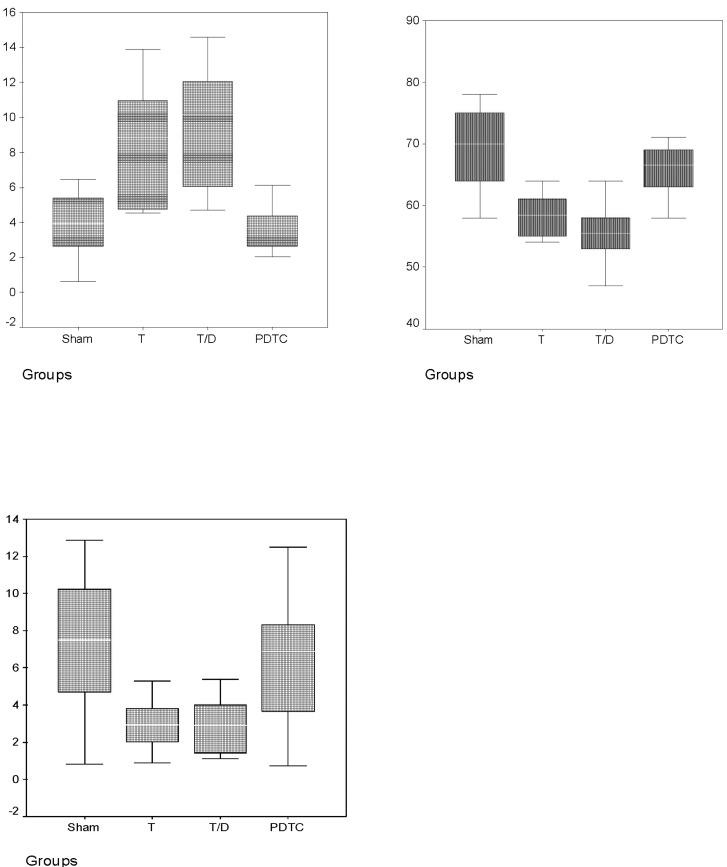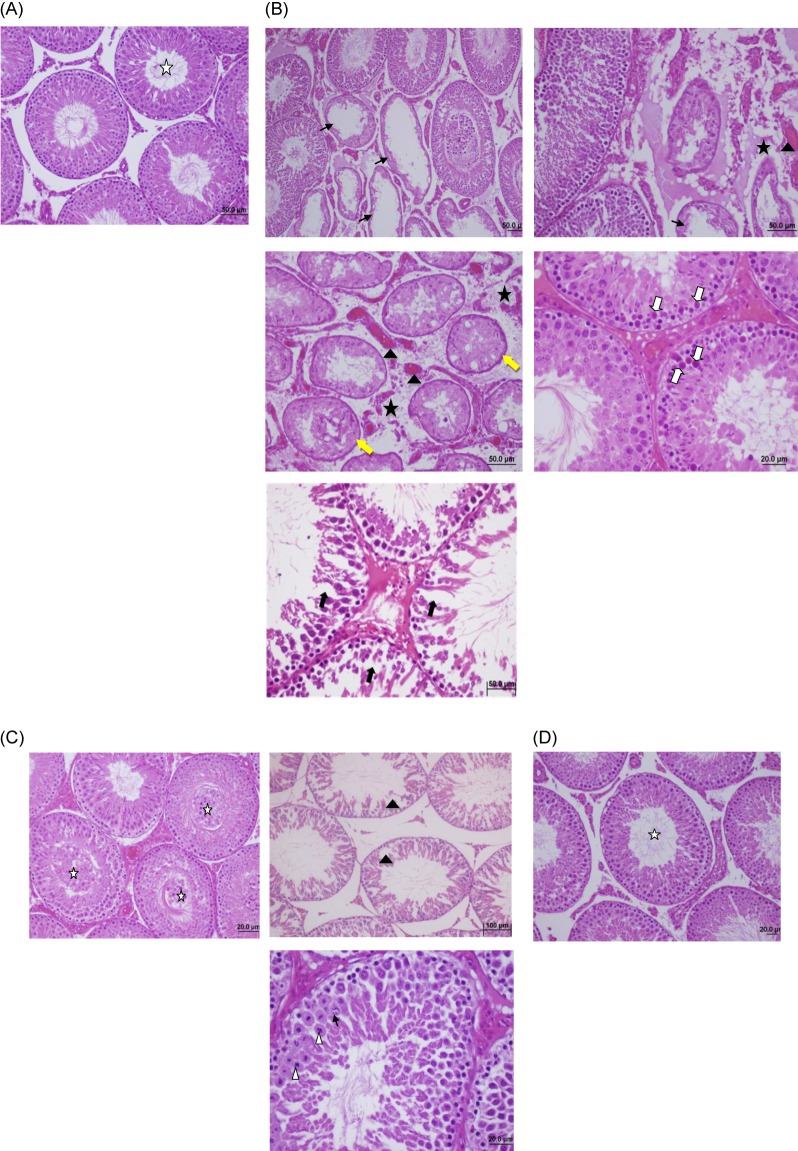Korean J Physiol Pharmacol.
2014 Aug;18(4):321-326. 10.4196/kjpp.2014.18.4.321.
Protective Effects of the Nuclear Factor Kappa B Inhibitor Pyrrolidine Dithiocarbamate on Experimental Testicular Torsion and Detorsion Injury
- Affiliations
-
- 1Department of Urology, Faculty of Medicine, Dumlupinar University, Kutahya 43100, Turkey. skabay@yahoo.com
- 2Department of Anatomy, Faculty of Medicine, Eskisehir Osmangazi University, Eskisehir 26100, Turkey.
- 3Department of Histology and Embryology, Faculty of Medicine, Eskisehir Osmangazi University, Eskisehir 26100, Turkey.
- 4Department of Medical Biology, Faculty of Medicine, Eskisehir Osmangazi University, Eskisehir 26100, Turkey.
- 5Bilecik Seyh Edebali University, Vocational School Health Services, Bilecik 11100, Turkey.
- 6Eskisehir Osmangazi University, Vocational School Health Services, Eskisehir 26100, Turkey.
- KMID: 2285526
- DOI: http://doi.org/10.4196/kjpp.2014.18.4.321
Abstract
- Testicular torsion results with the damage of the testis and it is a surgical emergency. Pyrrolidine dithiocarbamate (PDTC) is a low-molecular-weight antioxidant and potent inhibitor of nuclear factor kappa B (NF-kappaB) activation. In this study, we aimed to investigate the effects of PDTC to testicular torsion-detorsion (T/D) injury. Forty adult male Sprague-Dawley rats were separated into four groups. A sham operation was performed in group I. In group II, torsion is performed 2 hours by 720 degree extravaginally testis. In group III, 4 h reperfusion of the testis was performed after 2 h of testicular torsion. In group IV, after performing the same surgical procedures as in group III, PDTC (100 mg/kg, intravenous's) was administered before 30 min of detorsion. The testes tissue malondialdehyde (MDA), superoxide dismutase (SOD) catalase (CAT) level was evaluated. Histological evaluations were performed after hematoxylin and eosin staining. Testicular tissue MDA levels were the highest in the T/D groups compared with treatment group. Administration of PDTC prevented a further increase in MDA levels. Significant decrease occurred in CAT and SOD levels in treatment group compared with the control group. The rats in the treatment group had normal testicular architecture. The results suggest that PDTC can be a potential protective agent for preventing the biochemical and histological changes related to oxidative stress in testicular injury caused by testis torsion.
MeSH Terms
Figure
Reference
-
2. Anderson JB, Williamson RC. Testicular torsion in Bristol: a 25-year review. Br J Surg. 1988; 75:988–992. PMID: 3219547.
Article3. Ames BN. Endogenous oxidative DNA damage, aging, and cancer. Free Radic Res Commun. 1989; 7:121–128. PMID: 2684796.
Article4. de Groot H, Rauen U. Ischemia-reperfusion injury: processes in pathogenetic networks: a review. Transplant Proc. 2007; 39:481–484. PMID: 17362763.
Article5. Granger DN, Korthuis RJ. Physiologic mechanisms of postischemic tissue injury. Annu Rev Physiol. 1995; 57:311–332. PMID: 7778871.
Article6. Yang S, Shih HJ, Chow YC, Tsai PS, Huang CJ. Hemin induced heme oxygenase-1 over expression involves nuclear factor-E2 related factor-2, nuclear factor-kappaB and extracellular regulated kinase: an experimental study in a testicular torsion-detorsion rodent model. J Urol. 2008; 179:2456–2463. PMID: 18433787.7. Altavilla D, Romeo C, Squadrito F, Marini H, Morgia G, Antonuccio P, Minutoli L. Molecular pathways involved in the early and late damage induced by testis ischemia: evidence for a rational pharmacological modulation. Curr Med Chem. 2012; 19:1219–1224. PMID: 22300051.8. Orrenius S, Nobel CS, van den Dobbelsteen DJ, Burkitt MJ, Slater AF. Dithiocarbamates and the redox regulation of cell death. Biochem Soc Trans. 1996; 24:1032–1038. PMID: 8968507.
Article9. Iseki A, Kambe F, Okumura K, Niwata S, Yamamoto R, Hayakawa T, Seo H. Pyrrolidine dithiocarbamate inhibits TNF-alpha-dependent activation of NF-kappaB by increasing intracellular copper level in human aortic smooth muscle cells. Biochem Biophys Res Commun. 2000; 276:88–92. PMID: 11006087.10. Liu SF, Ye X, Malik AB. Inhibition of NF-kappaB activation by pyrrolidine dithiocarbamate prevents In vivo expression of proinflammatory genes. Circulation. 1999; 100:1330–1337. PMID: 10491379.11. Bowie A, O'Neill LA. Oxidative stress and nuclear factor-kappaB activation: a reassessment of the evidence in the light of recent discoveries. Biochem Pharmacol. 2000; 59:13–23. PMID: 10605930.12. Schreck R, Meier B, Männel DN, Dröge W, Baeuerle PA. Dithiocarbamates as potent inhibitors of nuclear factor kappa B activation in intact cells. J Exp Med. 1992; 175:1181–1194. PMID: 1314883.
Article13. Borrello S, Demple B. NF kappa B-independent transcriptional induction of the human manganous superoxide dismutase gene. Arch Biochem Biophys. 1997; 348:289–294. PMID: 9434740.14. Liu SF, Ye X, Malik AB. In vivo inhibition of nuclear factor-kappa B activation prevents inducible nitric oxide synthase expression and systemic hypotension in a rat model of septic shock. J Immunol. 1997; 159:3976–3983. PMID: 9378986.15. Si X, McManus BM, Zhang J, Yuan J, Cheung C, Esfandiarei M, Suarez A, Morgan A, Luo H. Pyrrolidine dithiocarbamate reduces coxsackievirus B3 replication through inhibition of the ubiquitin-proteasome pathway. J Virol. 2005; 79:8014–8023. PMID: 15956547.
Article16. Hartsfield CL, Alam J, Choi AM. Transcriptional regulation of the heme oxygenase 1 gene by pyrrolidine dithiocarbamate. FASEB J. 1998; 12:1675–1682. PMID: 9837857.
Article17. Mihara M, Uchiyama M. Determination of malonaldehyde precursor in tissues by thiobarbituric acid test. Anal Biochem. 1978; 86:271–278. PMID: 655387.18. Góth L. A simple method for determination of serum catalase activity and revision of reference range. Clin Chim Acta. 1991; 196:143–151. PMID: 2029780.
Article19. Saba M, Morales CR, De Lamirande E, Gagnon C. Morphological and biochemical changes following acute unilateral testicular torsion in prepubertal rats. J Urol. 1997; 157:1149–1154. PMID: 9072560.
Article20. Németh ZH, Haskó G, Vizi ES. Pyrrolidine dithiocarbamate augments IL-10, inhibits TNF-alpha, MIP-1alpha, IL-12, and nitric oxide production and protects from the lethal effect of endotoxin. Shock. 1998; 10:49–53. PMID: 9688091.21. Sun Z, Andersson R. NF-kappaB activation and inhibition: a review. Shock. 2002; 18:99–106. PMID: 12166787.22. Frossard JL, Pastor CM, Hadengue A. Effect of hyperthermia on NF-kappaB binding activity in cerulein-induced acute pancreatitis. Am J Physiol Gastrointest Liver Physiol. 2001; 280:G1157–G1162. PMID: 11352808.23. Orfila C, Lepert JC, Alric L, Carrera G, Béraud M, Pipy B. Immunohistochemical distribution of activated nuclear factor kappaB and peroxisome proliferator-activated receptors in carbon tetrachloride-induced chronic liver injury in rats. Histochem Cell Biol. 2005; 123:585–593. PMID: 15959796.24. Tugcu V, Ozbek E, Tasci AI, Kemahli E, Somay A, Bas M, Karaca C, Altug T, Cekmen MB, Ozdogan HK. Selective nuclear factor kappa-B inhibitors, pyrolidium dithiocarbamate and sulfasalazine, prevent the nephrotoxicity induced by gentamicin. BJU Int. 2006; 98:680–686. PMID: 16925772.25. Gu EY, Han HS, Park JS. Effect of minocycline on activation of glia and nuclear factor kappa B in an animal nerve injury model. Korean J Physiol Pharmacol. 2004; 8:237–243.26. Hidaka S, Funakoshi T, Shimada H, Tsuruoka M, Kojima S. Protective effect of N-benzyl-D-glucamine dithiocarbamate against renal toxicity in rats during repeated cis-diamminedichloroplatinum administrations. Ren Fail. 1995; 17:539–550. PMID: 8570866.27. Kojima S, Sugimura Y, Ono H, Shimada H, Funakoshi T. N-benzyl-D-glucamine dithiocarbamate and N-p-isopropylbenzyl-D-glucamine dithiocarbamate improve the protective effect of diethyldithiocarbamate against cadmium-induced testicular toxicity in rats. Biol Pharm Bull. 1993; 16:244–247. PMID: 8395932.
Article28. Schwartz MD, Moore EE, Moore FA, Shenkar R, Moine P, Haenel JB, Abraham E. Nuclear factor-kappa B is activated in alveolar macrophages from patients with acute respiratory distress syndrome. Crit Care Med. 1996; 24:1285–1292. PMID: 8706481.
Article29. Li C, Browder W, Kao RL. Early activation of transcription factor NF-kappaB during ischemia in perfused rat heart. Am J Physiol. 1999; 276:H543–H552. PMID: 9950856.30. Muller DN, Dechend R, Mervaala EM, Park JK, Schmidt F, Fiebeler A, Theuer J, Breu V, Ganten D, Haller H, Luft FC. NF-kappaB inhibition ameliorates angiotensin II-induced inflammatory damage in rats. Hypertension. 2000; 35:193–201. PMID: 10642297.31. Bach SP, Chinery R, O'Dwyer ST, Potten CS, Coffey RJ, Watson AJ. Pyrrolidinedithiocarbamate increases the therapeutic index of 5-fluorouracil in a mouse model. Gastroenterology. 2000; 118:81–89. PMID: 10611156.
Article32. Chen D, Peng F, Cui QC, Daniel KG, Orlu S, Liu J, Dou QP. Inhibition of prostate cancer cellular proteasome activity by a pyrrolidine dithiocarbamate-copper complex is associated with suppression of proliferation and induction of apoptosis. Front Biosci. 2005; 10:2932–2939. PMID: 15970547.
Article33. Morais C, Pat B, Gobe G, Johnson DW, Healy H. Pyrrolidine dithiocarbamate exerts anti-proliferative and pro-apoptotic effects in renal cell carcinoma cell lines. Nephrol Dial Transplant. 2006; 21:3377–3388. PMID: 16998220.
Article34. Arima N, Arimura K, Tokito Y, Sakaki Y, Matsushita K, Orihara K, Akimoto M, Ozaki A, Kukita T, Hagiwara T, Hamada H, Tei C. HTLV-I Tax protein inhibits apoptosis induction but not G1 arrest by pyrrolidinedithiocarbamate, an anti-oxidant, in adult T cell leukemia cells. Exp Hematol. 2004; 32:195–201. PMID: 15102481.
Article35. Milacic V, Chen D, Giovagnini L, Diez A, Fregona D, Dou QP. Pyrrolidine dithiocarbamate-zinc(II) and -copper(II) complexes induce apoptosis in tumor cells by inhibiting the proteasomal activity. Toxicol Appl Pharmacol. 2008; 231:24–33. PMID: 18501397.
Article36. Chae HJ, Bae J, Chae SW. PDTC Inhibits TNF-α-Induced Apoptosis in MC3T3E1 Cells. Korean J Physiol Pharmacol. 2003; 7:199–206.37. Zhang H, Wu JS, Peng F. Potent anticancer activity of pyrrolidine dithiocarbamate-copper complex against cisplatin-resistant neuroblastoma cells. Anticancer Drugs. 2008; 19:125–132. PMID: 18176108.
Article38. Chatterjee PK, di Villa Bianca RD, Sivarajah A, McDonald MC, Cuzzocrea S, Thiemermann C. Pyrrolidine dithiocarbamate reduces renal dysfunction and injury caused by ischemia/reperfusion of the rat kidney. Eur J Pharmacol. 2003; 482:271–280. PMID: 14660032.
Article39. Li J, Sheng W, Feng C, Zuo Z. Pyrrolidine dithiocarbamate attenuates brain Aβ increase and improves long-term neurological outcome in rats after transient focal brain ischemia. Neurobiol Dis. 2012; 45:564–572. PMID: 21983158.
Article40. Teke Z, Kabay B, Aytekin FO, Yenisey C, Demirkan NC, Sacar M, Erdem E, Ozden A. Pyrrolidine dithiocarbamate prevents 60 minutes of warm mesenteric ischemia/reperfusion injury in rats. Am J Surg. 2007; 194:255–262. PMID: 17618816.
Article41. Teke Z, Aytekin FO, Kabay B, Yenisey C, Aydin C, Tekin K, Sacar M, Ozden A. Pyrrolidine dithiocarbamate prevents deleterious effects of remote ischemia/reperfusion injury on healing of colonic anastomoses in rats. World J Surg. 2007; 31:1835–1842. PMID: 17566823.
Article42. Mallick IH, Yang WX, Winslet MC, Seifalian AM. Pyrrolidine dithiocarbamate reduces ischemia-reperfusion injury of the small intestine. World J Gastroenterol. 2005; 11:7308–7313. PMID: 16437633.
Article43. Tian XF, Yao JH, Li YH, Gao HF, Wang ZZ, Yang CM, Zheng SS. Protective effect of pyrrolidine dithiocarbamate on liver injury induced by intestinal ischemia-reperfusion in rats. Hepatobiliary Pancreat Dis Int. 2006; 5:90–95. PMID: 16481291.44. Kabay B, Teke Z, Aytekin FO, Yenisey C, Bir F, Sacar M, Erdem E, Ozden A. Pyrrolidine dithiocarbamate reduces lung injury caused by mesenteric ischemia/reperfusion in a rat model. World J Surg. 2007; 31:1707–1715. PMID: 17551782.
Article45. El Eter E, Hagar HH, Al-Tuwaijiri A, Arafa M. Nuclear factor-kappaB inhibition by pyrrolidinedithiocarbamate attenuates gastric ischemia-reperfusion injury in rats. Can J Physiol Pharmacol. 2005; 83:483–492. PMID: 16049548.46. Ilbey YO, Ozbek E, Simsek A, Cekmen M, Otunctemur A, Somay A. Chemoprotective effect of a nuclear factor-kappaB inhibitor, pyrrolidine dithiocarbamate, against cisplatin-induced testicular damage in rats. J Androl. 2009; 30:505–514. PMID: 19234314.
- Full Text Links
- Actions
-
Cited
- CITED
-
- Close
- Share
- Similar articles
-
- Recurrences of testicular torsion after manual detorsion: a single institution experience
- The Effect of Free Radical Scavengers on Reperfusion Injury after Testicular Torsion
- The effect of testicular torsion on the contralateral testis in rats
- The Effect of Testicular Torsion on the Histologic Findings and Apoptosis of the Contralateral Testis at Various Ages in Rats
- The Mechanism of Damage to the Contralateral Testis Following Testicular Torsion and Detorsion in Rats and the Effect of Allopurinol Administration



